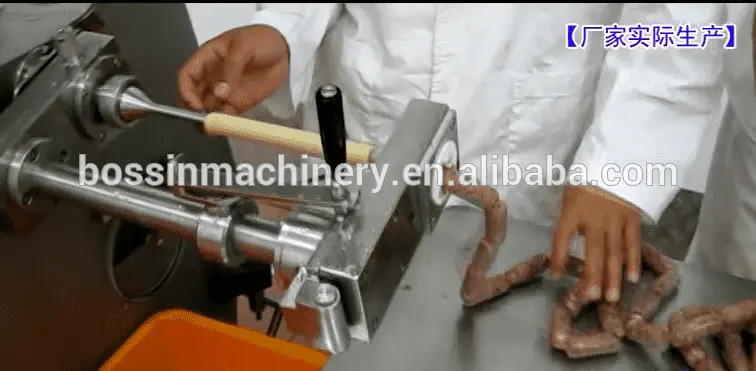નવેમ્બર . 26, 2024 08:19 Back to list
Commercial Production of Sausage Fillers in Manufacturing Facilities and Their Impact on Industry
Exploring the World of Commercial Sausage Filler Factories
The global food industry is a complex tapestry of various processes, technologies, and innovations that come together to deliver the diverse range of products that consumers enjoy today. Among these, the production of sausages stands out as a venerable tradition and a significant sector within the commercial meat industry. Central to this process are commercial sausage filler factories, where advanced machinery and skilled labor converge to create a wide array of sausage products.
The Process of Sausage Filling
Sausage making is both an art and a science. The process begins with the careful selection of high-quality meat, which may include pork, beef, chicken, or a blend of proteins, along with various spices, seasonings, and fillers that enhance flavor and texture. In commercial sausage filler factories, the initial steps involve grinding the selected meats, mixing them with seasonings, and adding any fillers that may be necessary for texture, preservation, or cost efficiency.
Once the mixture is ready, the filling process begins. This is where commercial sausage fillers play a crucial role. These machines are designed to efficiently and uniformly fill sausage casings—either natural or synthetic—with the meat mixture. The use of these machines allows for consistent sizing and weight of sausages, which is essential for meeting consumer expectations and regulatory standards.
Technology and Innovation
Commercial sausage filler factories have embraced technological advances that significantly improve both the efficiency and quality of sausage production. Modern fillers are equipped with digital controls that allow for precise measurements and adjustments, reducing waste and ensuring uniformity. Additionally, many factories utilize advanced systems for monitoring and controlling temperatures, which is vital for food safety and product integrity.
The automation of the filling process has also led to increased productivity. In a bustling factory, machines can fill hundreds or even thousands of sausages an hour, far surpassing what could be accomplished manually. This increase in efficiency allows for greater output, which is crucial to meet the demands of a competitive market.
Moreover, technology has enabled the introduction of specialty sausages, accommodating a wide range of dietary preferences and restrictions. From gluten-free and plant-based options to spicy chorizo and artisanal varieties, commercial sausage factories can cater to diverse consumer tastes. This adaptability is key to maintaining market relevance and satisfying changing consumer behavior.
commercial sausage filler factories

Quality Control and Safety
Quality control is paramount in commercial sausage filler factories. The production process involves rigorous testing and inspection to ensure that every sausage meets the established food safety and quality standards. This includes monitoring the sourcing of ingredients, the cleanliness of the production environment, and the accuracy of machinery settings.
Safety protocols are a vital component of the manufacturing process. Many factories implement Hazard Analysis and Critical Control Points (HACCP) systems to identify and mitigate potential safety risks at all stages of production. Regular training of employees on hygiene practices and equipment operation further strengthens the commitment to producing safe and high-quality sausage products.
Sustainability in Production
As consumer awareness of sustainability increases, many sausage filler factories are exploring eco-friendly practices. This includes sourcing meat from suppliers who adhere to ethical farming practices, reducing energy consumption in production processes, and minimizing waste. Initiatives such as composting organic materials and utilizing renewable energy sources are becoming more common in the industry.
Additionally, innovations in packaging are contributing to sustainability efforts. Many factories are moving towards recyclable and biodegradable materials, reducing the environmental impact associated with sausage packaging.
Conclusion
Commercial sausage filler factories represent an intersection of tradition, technology, and culinary creativity. They play a crucial role in producing a beloved food product that is enjoyed in countless forms around the world. With the ongoing advancements in technology, stringent quality control measures, and a growing focus on sustainability, the future of sausage production looks promising. As these factories continue to innovate and adapt to changing consumer preferences, they will undoubtedly remain a staple of the global food industry for years to come.
Latest news
-
Pneumatic Clipping Machine-Shijiazhuang Bossin Machinery|Efficient Sausage Production&Cost-Effective Solution
NewsAug.15,2025
-
Pneumatic Clipping Machine - Shijiazhuang Bossin Machinery | Sausage Production Line, Automated Clipping, Precision Efficiency
NewsAug.15,2025
-
Pneumatic Clipping Machine-Shijiazhuang Bossin Machinery|Precision Sausage Production&Efficient Automation
NewsAug.15,2025
-
GZB80 Meat Bowl Cutter: High-Speed Precision for Emulsification
NewsAug.15,2025
-
Pneumatic Clipping Machine - Shijiazhuang Bossin Machinery | Sausage Production Line, Meat Shop Equipment
NewsAug.15,2025
-
Pneumatic Clipping Machine - Shijiazhuang Bossin Machinery Equipment Co., Ltd.|Efficient Sausage Clipping&Seamless Integration
NewsAug.14,2025
